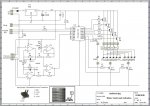darb1972
Senior Member
Hi All
I would like to design and build a Water Tank Level Meter for my home.
I have found in the past (on this forum) several projects surrounding the reading/monitoring of water tank levels. One was of particular interest, and it used an ultrasonic sensor, but (from vague memory) I think it might have been somewhat of a challenge to use and/or calibrate. I can't remember the exact details.
Anyway, more recently I found this article http://www.siliconchip.com.au/Issue/2018/February. It is part of a magazine that I subscribe to on a monthly basis. I can't reproduce the article here (for reasons of copy-write) but I believe that non-subscribers can read the first page or so from my supplied link. Hopefully that gives you an idea on what I want to do.
The project uses a submersible sensor that works on the water pressure of the tank (http://www.siliconchip.com.au/Shop/7/4283?default_options=). I believe the sensor is purpose made for this exact application. The project also links to a network via WiFi. It uses a Cloud based website for data storage and reporting. It also does humidity and temperature, but I'm not concerned either way whether I have these features in my project. I do have nearby mains power for the project, but it might be nice to operate the system off solar (like the magazine project). I can purchase the item/s I need from the magazine or online (like the sensor for example).
The designer based the whole thing around an Arduino platform, complete with shield PCBs. Frankly I don't really want to use another platform (and learn yet another language. I still haven't mastered the PICaxe environment) and I would much prefer to stick with PICaxe. What do others think??? Am I trying to "reinvent the wheel" or would a PICaxe based system (maybe like a 28X2 on a shield - AXE401) handle such a project???
Thanks all.
Regards
Brad
I would like to design and build a Water Tank Level Meter for my home.
I have found in the past (on this forum) several projects surrounding the reading/monitoring of water tank levels. One was of particular interest, and it used an ultrasonic sensor, but (from vague memory) I think it might have been somewhat of a challenge to use and/or calibrate. I can't remember the exact details.
Anyway, more recently I found this article http://www.siliconchip.com.au/Issue/2018/February. It is part of a magazine that I subscribe to on a monthly basis. I can't reproduce the article here (for reasons of copy-write) but I believe that non-subscribers can read the first page or so from my supplied link. Hopefully that gives you an idea on what I want to do.
The project uses a submersible sensor that works on the water pressure of the tank (http://www.siliconchip.com.au/Shop/7/4283?default_options=). I believe the sensor is purpose made for this exact application. The project also links to a network via WiFi. It uses a Cloud based website for data storage and reporting. It also does humidity and temperature, but I'm not concerned either way whether I have these features in my project. I do have nearby mains power for the project, but it might be nice to operate the system off solar (like the magazine project). I can purchase the item/s I need from the magazine or online (like the sensor for example).
The designer based the whole thing around an Arduino platform, complete with shield PCBs. Frankly I don't really want to use another platform (and learn yet another language. I still haven't mastered the PICaxe environment) and I would much prefer to stick with PICaxe. What do others think??? Am I trying to "reinvent the wheel" or would a PICaxe based system (maybe like a 28X2 on a shield - AXE401) handle such a project???
Thanks all.
Regards
Brad
Last edited:


